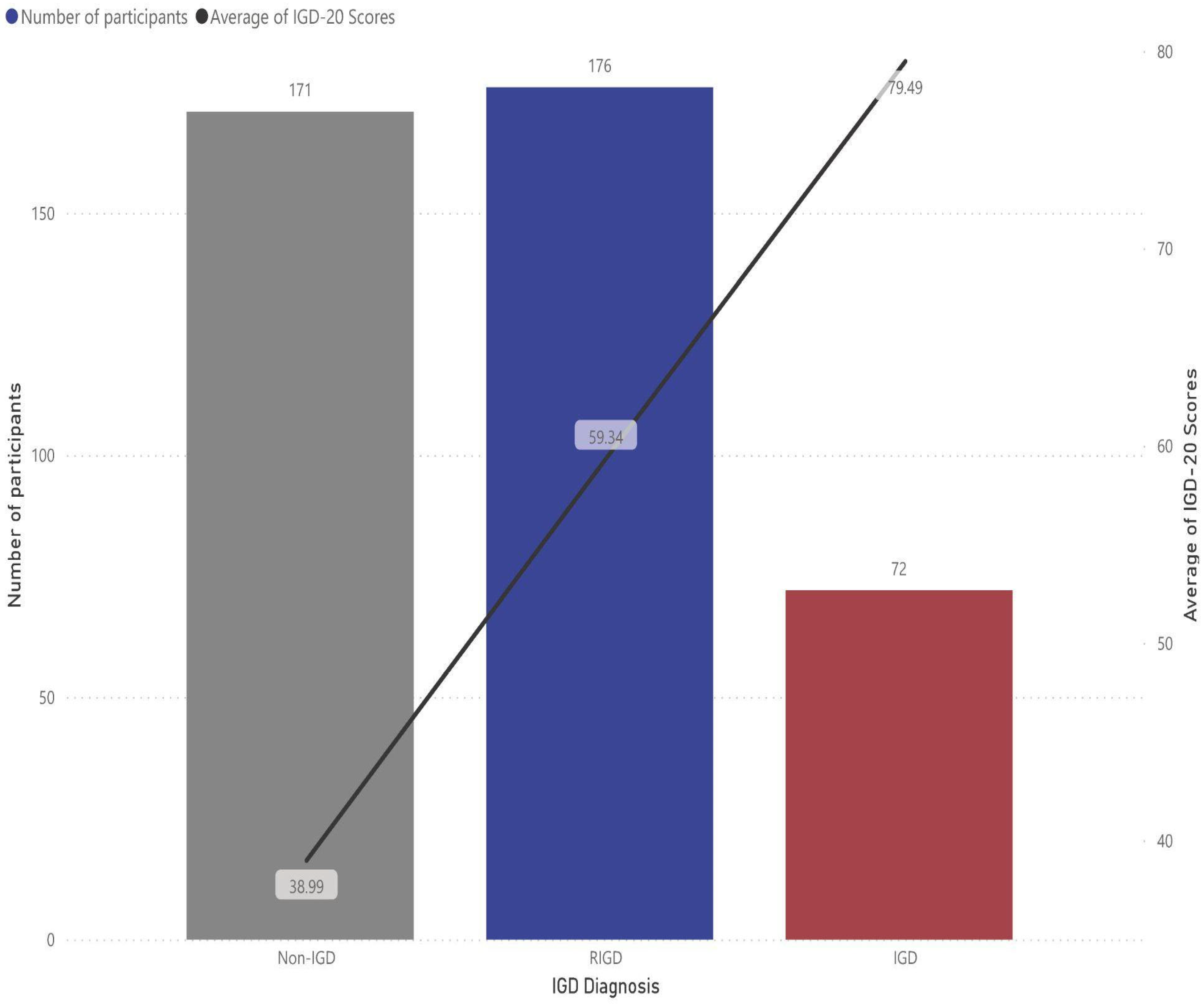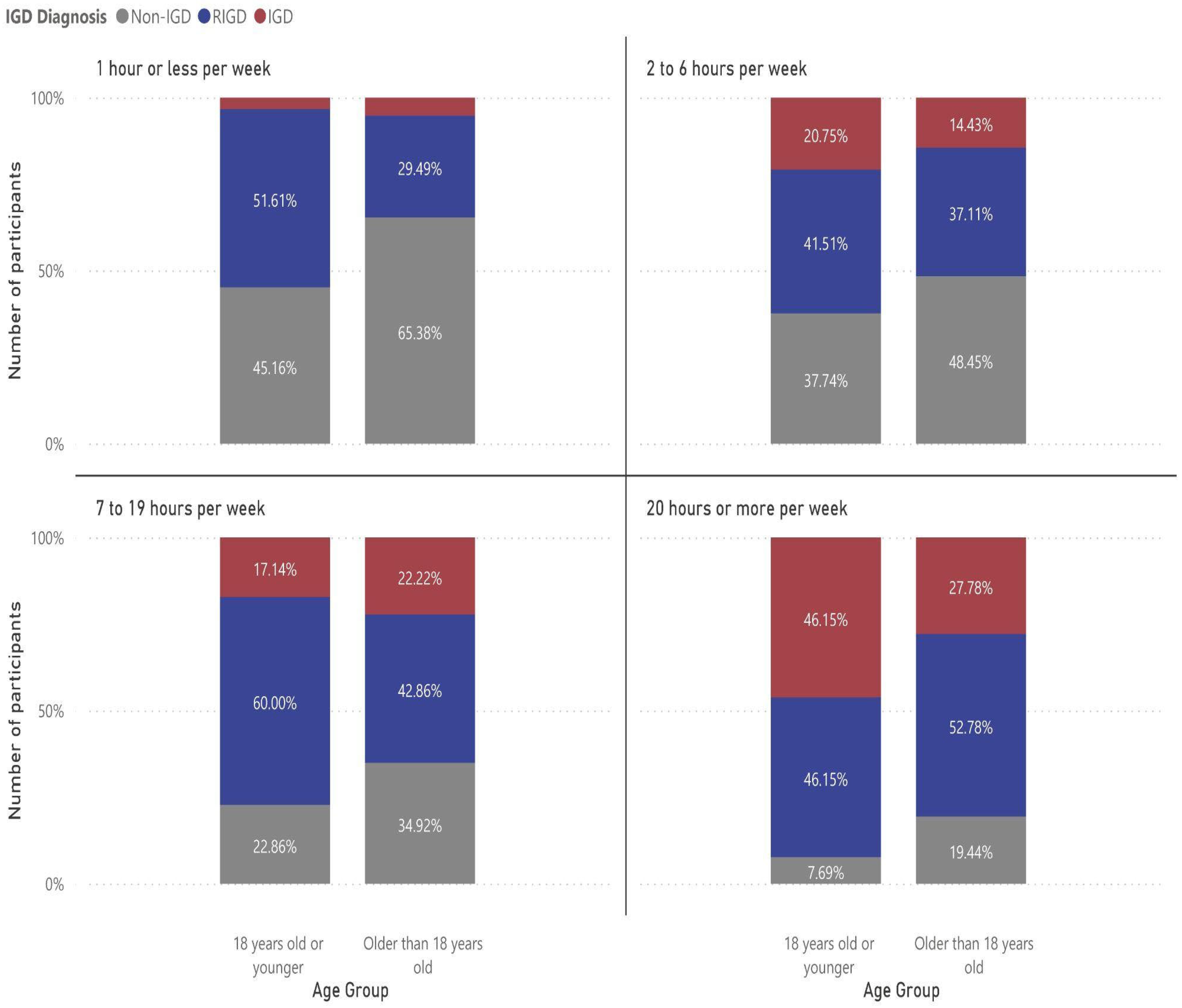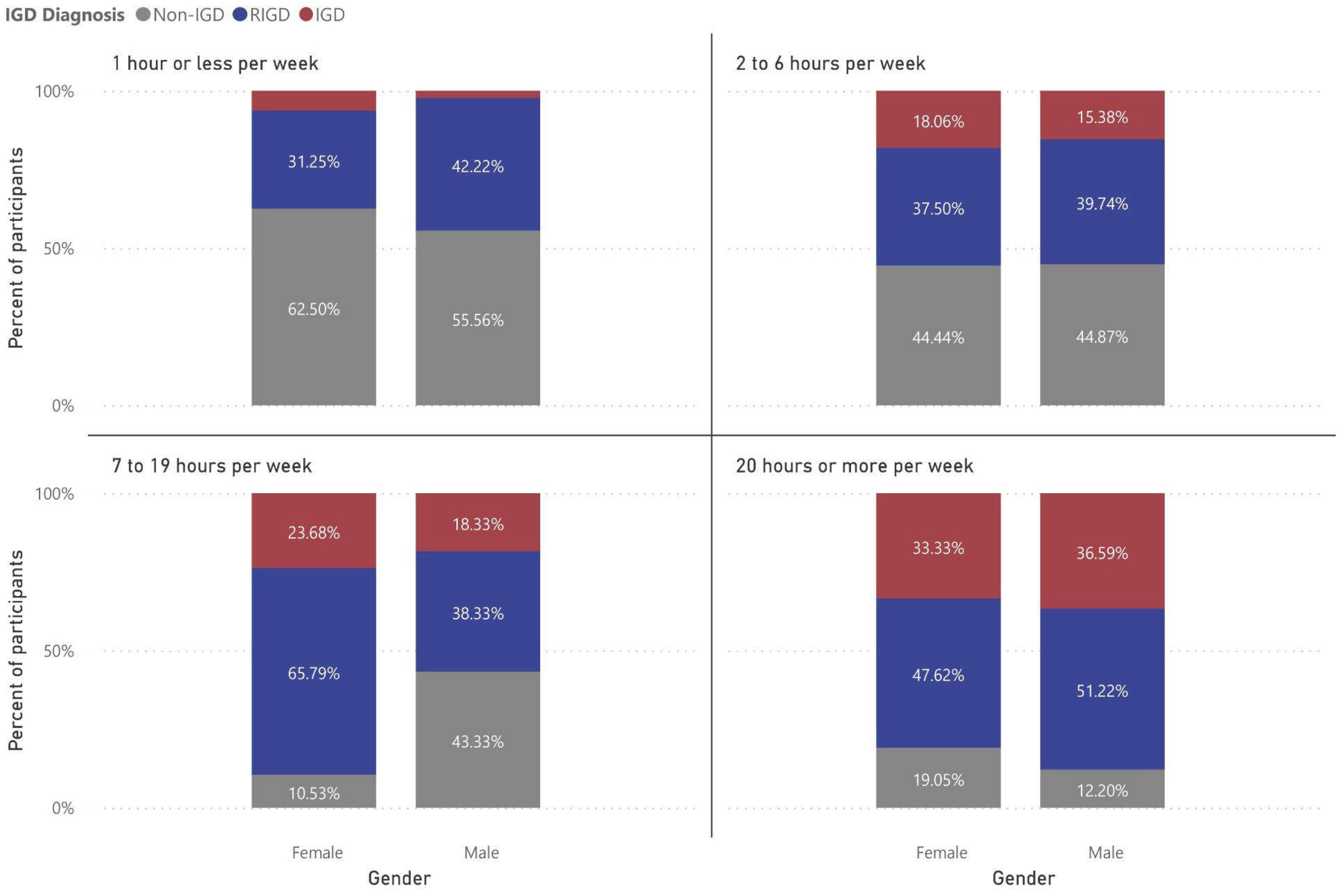Submitted:
15 January 2023
Posted:
17 January 2023
You are already at the latest version
Abstract
Keywords:
1. Introduction
2. Methods
2.1. Study Design and Settings
2.2. Study Population
2.3. Instruments
2.4. Statistical Modeling
3. Results
4. Discussion
5. Conclusions
6. Limitations
7. Future Studies
Author Contributions
Funding
Institutional Review Board Statement
Data Availability Statement
Acknowledgments
Conflicts of Interest
Abbreviations
| IGD | Internet Gaming Disorder |
| IRB | Institutional Review Board |
| LR | linear regression |
| OR | odds ratio |
| APA | The American Psychological Association |
| DSM-5 | The Diagnostic and Statistical Manual of Mental Disorders, Fifth Edition |
| IGD-20 Test | internet gaming disorder test |
| USD | US dollar |
| 95% CI | 95% confidence interval |
| PSP | PlayStation Portable |
References
- American Psychiatric Association: Diagnostic and Statistical Manual of Mental Disorders: DSM-5. Washington DC: American Psychiatric Association. 2013795796. 10.1176/appi.books.9780890425596https://dsm.psychiatryonline.org/doi/book/10.1176/appi.books.9780890425596.
- Mihara, S., & Higuchi, S. (2017: Cross-sectional and longitudinal epidemiological studies of Internet gaming disorder: A systematic review of the literature. Psychiatry and Clinical Neurosciences. 71:425-444. [CrossRef]
- Männikkö, N., Billieux, J., & Kääriäinen, M. (2015: Problematic digital gaming behavior and its relation to the psychological, social and physical health of Finnish adolescents and young adults. Journal of Behavioral Addictions. 4:281-288.
- Müller, K. W., Janikian, M., Dreier,: Regular gaming behavior and internet gaming disorder in European adolescents: results from a cross-national representative survey of prevalence, predictors, and psychopathological correlates. European Child & Adolescent Psychiatry. 24:565-574. [CrossRef]
- Hoeft, F., Watson, C. L., Kesler,: Gender differences in the mesocorticolimbic system during computer game-play. Journal of Psychiatric Research. 42:253-258. [CrossRef]
- Kuss, D. J., & Griffiths, M. D. (2012: Internet and Gaming Addiction: A Systematic Literature Review of Neuroimaging Studies. Brain Sciences. 2:347-374. [CrossRef]
- Han, D. H., Lyoo, I. K., & Renshaw, P. F. (2012: Differential regional gray matter volumes in patients with on-line game addiction and professional gamers. Journal of Psychiatric Research. 46:507-515. [CrossRef]
- Han, D. H., Hwang, J. W., & Renshaw, P. F. (2010: Bupropion sustained release treatment decreases craving for video games and cue-induced brain activity in patients with Internet video game addiction. Experimental and Clinical Psychopharmacology. 18:297-304. [CrossRef]
- Ko, C.-H., Liu, G.-C., Hsiao,: Brain activities associated with gaming urge of online gaming addiction. Journal of Psychiatric Research, 43, 739-747. [CrossRef]
- Littel, M., van den Berg, I., Luijten, M.,: Error processing and response inhibition in excessive computer game players: an event-related potential study. Addiction Biology. 17:934-947. [CrossRef]
- Festl, R., Scharkow, M., & Quandt, T. (2012: Problematic computer game use among adolescents, younger and older adults. Addiction, 108, 592-599.
- Hakala, P. T., Rimpelä, A. H., Saarni, L. A.,: Frequent computer-related activities increase the risk of neck-shoulder and low back pain in adolescents. European Journal of Public Health, 16, 536-541. [CrossRef]
- Tafà, M., & Baiocco, R. (2009: Addictive Behavior and Family Functioning During Adolescence. The. American Journal of Family Therapy, 37, 388-395. [CrossRef]
- Bonnaire, C., & Phan, O. (2017: Relationships between parental attitudes, family functioning and Internet gaming disorder in adolescents attending school. Psychiatry Research. 255:104-110. [CrossRef]
- Han, D. H., Kim, S. M., Lee, Y. S.,: The effect of family therapy on the changes in the severity of on-line game play and brain activity in adolescents with on-line game addiction. Psychiatry Research: Neuroimaging, 202, 126-131. [CrossRef]
- King, D. L., Chamberlain, S. R., Carragher,: N., Rumpf, H. J., Saunders, J., Starcevic, V., Demetrovics, Z., Brand, M., Lee, H. K., Spada, M., Lindenberg, K., Wu, A. M. S., Lemenager, T., Pallesen, S., Achab, S., … Delfabbro, P. H. 2020, 77:101831.
- Hendricks, S., Düking, P. and Mellalieu, S., 2016: Twitter Strategies for Web-Based Surveying: Descriptive Analysis From the International Concussion Study. 5317920163179272021. [CrossRef]
- Hawi NS, Samaha M: Validation of the Arabic Version of the Internet Gaming Disorder-20 Test. Cyberpsychol Behav Soc Netw. 2017, 20:268-272. [CrossRef]
- Pontes, H. M., Király, O., Demetrovics, Z.,: The Conceptualisation and Measurement of DSM-5 Internet Gaming Disorder: The Development of the IGD-20 Test. 910. [CrossRef]
- Saquib, N., Saquib, J., Wahid, A. W.,: Video game addiction and psychological distress among expatriate adolescents in Saudi Arabia. Addictive Behaviors Reports. 6:112-117. [CrossRef]
- Rajab, A. M., Zaghloul, M. S., Enabi, S.,: M., Basalah, A., Alchalati, S. W., Enabi, J., Aljundi, S., Billah, S. M., Saquib, J., AlMazrou, A. R., & Saquib, N. 2020, 11:100261.
- Al Asqah, M. I., Al Orainey, A. I., Shukr, M. A.,: The prevalence of internet gaming disorder among medical students at King. Saud University, Riyadh, Saudi Arabia. Saudi Medical Journal. 41:1359-1363.
- Billieux, Joel & Potenza, Marc & Maurage, Pierre & Brevers, Damien & Brand, Matthias & King, Daniel. (2020). Cognitive factors associated with gaming disorder. [CrossRef]
- Hawi NS, Samaha M, Griffiths MD. Internet gaming disorder in Lebanon: Relationships with age, sleep habits, and academic achievement. J Behav Addict. 2018 Mar 1;7(1):70-78. Epub 2018 Feb 28. PMID: 29486571; PMCID: PMC6035028. [CrossRef]
- Kim, H. S., Son, G., Roh, E.-B., Ahn, W.-Y., Kim, J., Shin, S.-H., Chey, J., & Choi, K.-H. (2022). Prevalence of gaming disorder: A meta-analysis. Addictive Behaviors, 126, 107183. [CrossRef]
- Alfaifi, A. J., Mahmoud, S. S., Elmahdy, M. H., & Gosadi, I. M. (2022). Prevalence and factors associated with Internet gaming disorder among adolescents in Saudi Arabia: A cross-sectional study. Medicine, 101(26), E29789. [CrossRef]
- Alhamoud, M. A., Alkhalifah, A. A., Althunyan, A. K., Mustafa, T., Alqahtani, H. A., & al Awad, F. A. (2022). Internet gaming disorder: Its prevalence and associated gaming behavior, anxiety, and depression among high school male students, Dammam, Saudi Arabia. Journal of Family & Community Medicine, 29(2), 93. [CrossRef]
- Alsunni AA, Latif R. Internet gaming disorder and its correlates among university students, Saudi Arabia. J Family Community Med. 2022 Sep-Dec;29(3):217-222. Epub 2022 Sep 7. PMID: 36389029; PMCID: PMC9664466. [CrossRef]
- The Kingdom of Saudi Arabia’s Experience in Health Preparedness and Response to COVID-19 Pandemic. (2020, August). Ministry of Health. https://www.moh.gov.sa/en/Ministry/MediaCenter/Publications/Documents/COVID-19-NATIONAL.pdf.
- Han, T. sun, Cho, H., Sung, D., & Park, M. H. (2022). A systematic review of the impact of COVID-19 on the game addiction of children and adolescents. Frontiers in Psychiatry, 13, 1904. [CrossRef]
- Alsaad, A., Alabdulmuhsin, F., Alamer, Z., Alhammad, Z., Al-Jamaan, K., & Al-sultan, Y. (2021). Impact of the COVID-19 pandemic quarantine on gaming behavior among children and adolescents in the Eastern Province of Saudi Arabia. International Journal of Medicine in Developing Countries, 1007–1014. [CrossRef]
- Wu, A. M. S., Chen, J. H., Tong, K. K., Yu, S., & Lau, J. T. F. (2018). Prevalence and associated factors of Internet gaming disorder among community dwelling adults in Macao, China. Journal of Behavioral Addictions, 7(1). [CrossRef]
- Kim, N. R., Hwang, S. S. H., Choi, J. S., Kim, D. J., Demetrovics, Z., Király, O., Nagygyörgy, K., Griffiths, M. D., Hyun, S. Y., Youn, H. C., & Choi, S. W. (2016). Characteristics and Psychiatric Symptoms of Internet Gaming Disorder among Adults Using Self-Reported DSM-5 Criteria. Psychiatry Investigation, 13(1), 58–66. [CrossRef]
- Abdel-Salam, D. M., Alrowaili, H. I., Albedaiwi, H. K., Alessa, A. I., & Alfayyadh, H. A. (2019). Prevalence of internet addiction and its associated factors among female students at Jouf University, Saudi Arabia. Journal of the Egyptian Public Health Association, 94(1), 1–8. [CrossRef]
- Verlinden, M., Thomas, J., Almansoori, M. H. A. A., & Wanigaratne, S. (2021). Gaming Disorder and Well-Being Among Emirati College Women. Frontiers in Psychiatry, 12. [CrossRef]
- Liao, Z., Huang, Q., Huang, S., Tan, L., Shao, T., Fang, T., Chen, X., Lin, S., Qi, J., Cai, Y., & Shen, H. (2020). Prevalence of Internet Gaming Disorder and Its Association With Personality Traits and Gaming Characteristics Among Chinese Adolescent Gamers. Frontiers in Psychiatry, 11. [CrossRef]
- Schneider, L. A., King, D. L., & Delfabbro, P. H. (2017). Family factors in adolescent problematic Internet gaming: A systematic review. Journal of Behavioral Addictions, 6(3), 321–333. [CrossRef]
- Severo, R. B., Soares, J. M., Affonso, J. P., Giusti, D. A., de Souza Junior, A. A., de Figueiredo, V. L., Pinheiro, K. A., & Pontes, H. M. (2020). Prevalence and risk factors for internet gaming disorder. Revista Brasileira de Psiquiatria (Sao Paulo, Brazil : 1999), 42(5), 532–535. [CrossRef]



| IGD Diagnosis | Non-IGD (N=171) | RIGD (N= 176) | IGD (N=72) | Chi-squared test | |||
|---|---|---|---|---|---|---|---|
| Categorical variables | N | % | N | % | N | % | |
| Age Group | X2=10.096*** | ||||||
| 18 years old or younger | 44 | 25.70% | 71 | 40.30% | 30 | 41.70% | |
| Older than 18 years old | 127 | 74.30% | 105 | 59.70% | 42 | 58.30% | |
| Gender | X2=0.019 | ||||||
| Female | 80 | 46.80% | 82 | 46.60% | 33 | 45.80% | |
| Male | 91 | 53.20% | 94 | 53.40% | 39 | 54.20% | |
| Nationality | X2=1.404 | ||||||
| Saudi | 157 | 91.80% | 165 | 93.80% | 69 | 95.80% | |
| Non-Saudi | 14 | 8.20% | 11 | 6.20% | 3 | 4.20% | |
| Residence | X2=1.459 | ||||||
| Riyadh | 94 | 55% | 96 | 54.50% | 45 | 62.50% | |
| Other | 77 | 45% | 80 | 45.50% | 27 | 37.50% | |
| Family Income | X2=3.567 | ||||||
| Less than 5000 Riyals | 23 | 13.50% | 30 | 17% | 7 | 9.70% | |
| 5000 to 9999 Riyals | 45 | 26.30% | 50 | 28.40% | 21 | 29.20% | |
| 10000 to 14999 Riyals | 44 | 25.70% | 37 | 21% | 16 | 22.20% | |
| More than 15000 Riyals | 59 | 34.50% | 59 | 33.50% | 28 | 38.90% | |
| Time Playing Per Week | X2=49.256*** | ||||||
| 1 hour or less per week | 65 | 38% | 39 | 22.20% | 5 | 6.90% | |
| 2 to 6 hours per week | 67 | 39.20% | 58 | 33% | 25 | 34.70% | |
| 7 to 19 hours per week | 30 | 17.50% | 48 | 27.30% | 20 | 27.80% | |
| 20 hours or more per week | 9 | 5.30% | 31 | 17.60% | 22 | 30.60% | |
| Numerical variables | Mean | SD | Mean | SD | Mean | SD | F-test |
| Age | 22.322 | 6.877 | 20.511 | 6.024 | 22.111 | 11.219 | F=2.801* |
| IGD-20 Questions | |||||||
| 1. I often lose sleep because of long gaming sessions | 2.468 | 1.144 | 3.432 | 0.948 | 4.056 | 0.902 | F=72.539*** |
| 2R. I never play games in order to feel better. | 2.76 | 1.22 | 3.193 | 0.996 | 3.5 | 1.035 | F=13.405*** |
| 3. I have significantly increased the amount of time I play games over last year | 2.17 | 1.193 | 3.352 | 1.176 | 4.111 | 1.069 | F=84.122*** |
| 4. When I am not gaming, I feel more irritable | 1.351 | 0.681 | 2.381 | 0.943 | 3.639 | 1.179 | F=173.542*** |
| 5. I have lost interest in other hobbies because of my gaming | 1.55 | 0.855 | 2.869 | 1.121 | 4.097 | 0.995 | F=181.281*** |
| 6. I would like to cut down my gaming time but it’s difficult to do so | 1.918 | 1.008 | 3.182 | 1.053 | 4.097 | 1.103 | F=128.27*** |
| 7. I usually think about my next gaming session when I am not playing | 1.942 | 0.944 | 3.034 | 0.881 | 4.194 | 0.781 | F=173.459*** |
| 8. I play games to help me cope with any bad feelings I might have | 2.643 | 1.272 | 3.648 | 1.157 | 4.292 | 1.013 | F=58.889*** |
| 9. I need to spend increasing amounts of time engaged in playing games | 2.076 | 1.035 | 2.869 | 0.913 | 3.889 | 1.082 | F=87.635*** |
| 10. I feel sad if I am not able to play games | 1.38 | 0.712 | 2.443 | 1.001 | 3.917 | 1.045 | F=205.96*** |
| 11. I have lied to my family members because of the amount of gaming I do | 1.351 | 0.699 | 2.483 | 1.126 | 3.75 | 1.275 | F=153.249*** |
| 12. I do not think I could stop gaming | 1.749 | 1.035 | 2.858 | 1.104 | 4.25 | 0.765 | F=157.44*** |
| 13. I think gaming has become the most time-consuming activity in my life | 2.105 | 1.198 | 3.494 | 1.085 | 4.5 | 0.605 | F=147.531*** |
| 14. I play games to forget about whatever’s bothering me | 2.778 | 1.31 | 3.79 | 0.942 | 4.222 | 0.967 | F=56.953*** |
| 15. I often think that a whole day is not enough to do everything I need to do in games | 1.637 | 0.852 | 2.636 | 1.033 | 4.153 | 0.944 | F=182.147*** |
| 16. I tend to get anxious if I can’t play games for any reason | 1.491 | 0.722 | 2.591 | 0.981 | 3.986 | 0.971 | F=210.8*** |
| 17. I think my gaming has jeopardized the relationship with my partner | 1.626 | 0.908 | 2.42 | 1.05 | 3.486 | 1.1 | F=90.073*** |
| 18. I often try to play games less but find I cannot | 1.69 | 0.87 | 2.722 | 1.035 | 4.111 | 0.897 | F=171.209*** |
| 19R. I know my main daily activity (i.e., occupation, education, homemaker, etc.) has not been negatively affected by my gaming | 2.222 | 1.341 | 2.608 | 1.176 | 3.097 | 1.302 | F=12.591*** |
| 20. I believe my gaming is negatively impacting important areas of my life | 2.082 | 1.195 | 3.335 | 1.104 | 4.139 | 0.893 | F=104.146*** |
| Parameters | Effect on slope | 95% CI | P-value | ||
|---|---|---|---|---|---|
| Estimate | SE | Lower limit | Upper limit | ||
| Intercept | 41.75 | 3.467 | 34.94 to | 48.57 | <0.0001 |
| Age Category [18 years old or younger] |
4.54 | 1.571 | 1.451 | 7.629 | 0.0041 |
| Sex [Male] | -1.172 | 1.516 | -4.153 | 1.808 | 0.4399 |
| Nationality [Saudi] | 3.903 | 3.053 | -2.097 | 9.904 | 0.2017 |
| Residence [Riyadh] | 0.5297 | 1.516 | -2.450 | 3.509 | 0.7269 |
| FamilyIncome [10000 to 14999 Riyals] |
-0.4199 | 2.542 | -5.416 | 4.577 | 0.8689 |
| FamilyIncome [More than 15000 Riyals] |
-0.6377 | 2.379 | -5.314 | 4.038 | 0.7888 |
| FamilyIncome [5000 to 9999 Riyals] |
0.719 | 2.439 | -4.076 | 5.514 | 0.7683 |
| TimePlayingPerWeek [2 to 6 hours per week] |
7.548 | 1.93 | 3.755 | 11.34 | 0.0001 |
| TimePlayingPerWeek [7 to 19 hours per week] |
11.83 | 2.151 | 7.598 | 16.05 | <0.0001 |
| TimePlayingPerWeek [20 hours or more per week] |
16.96 | 2.458 | 12.13 | 21.79 | <0.0001 |
Disclaimer/Publisher’s Note: The statements, opinions and data contained in all publications are solely those of the individual author(s) and contributor(s) and not of MDPI and/or the editor(s). MDPI and/or the editor(s) disclaim responsibility for any injury to people or property resulting from any ideas, methods, instructions or products referred to in the content. |
© 2023 by the authors. Licensee MDPI, Basel, Switzerland. This article is an open access article distributed under the terms and conditions of the Creative Commons Attribution (CC BY) license (http://creativecommons.org/licenses/by/4.0/).





